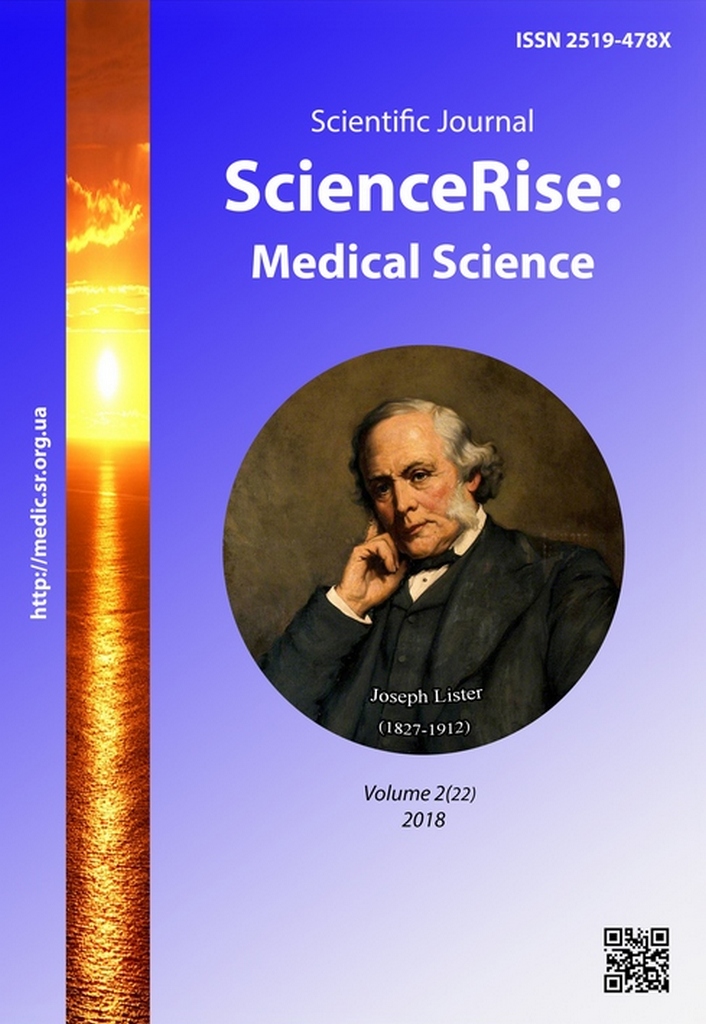Immune response of escherichiosis infected children with epstein-barr virus
DOI:
https://doi.org/10.15587/2519-4798.2018.124273Keywords:
Escherichiosis, Epshtein-Barr virus, children, cellular and humoral immunity, neutrophilsAbstract
The aim of the study was to investigate the features of the immune response on Escherichiosis in children infected with EBV.
Methods. The cellular and humoral links of the immune response, phagocytic activity of neutrophils in 84 early aged patients with Escherichiosis was performed, it included 28 children with persistent inactive (latent) EBV infection and 26 patients with active EBV infection. The control group consisted of 20 practically healthy children. Static processing of the obtained results was carried out by means of Excel and Statistica 6.0 applications.
Results. Different pathogenetic mechanisms of development of Escherichiosis have been revealed depending on the activity of EBV infection. The presence of latent or active EBV infection in patient with Escherichiosis leads to inhibition of cellular immunity and intension of the humoral immune response, signs of over-strain of the functional activity of neutrophils in acute period; in the case of latent form of EBV infection – a decrease in the functional reserve of the oxygen-dependent mechanism of bactericidal neutrophils. At the period of early convalescence of the disease, the complete recovery of the above indicators in patients with EBV infection does not occur.
Conclusions. The revealed changes in the immune response in patients with Escherichiosis infected with EBV should be taken into account for adequate treatment of these patients, as well as for medical observation at the stages of rehabilitation
References
- Libenko, V. N., Katarbayev, A. K., Mustafina, K. K., Golovenko, M. V. (2016). Kliniko-epidemiologicheskiye osobennosti esherikhiozov u detey na sovremennom etape. Vestnik, 1, 148–151.
- Delmas, Y., Vendrely, B., Clouzeau, B., Bachir, H., Bui, H.-N., Lacraz, A. et. al. (2013). Outbreak of Escherichia coli O104:H4 haemolytic uraemic syndrome in France: outcome with eculizumab. Nephrology Dialysis Transplantation, 29 (3), 565–572. doi: 10.1093/ndt/gft470
- Klimenko, T. M., Vorob'yeva, O. V., Gerasimov, I. G. (2008). Test vosstanovleniya neytrofilami nitrosinego tetrazoliya v diagnostike nekrotiziruyushchego enterokolita u nedonoshennykh novorozhdennykh. Zdorov'ye rebenka, 3 (12), 104–107.
- Murtazina, G. Kh., Fazylov, V. Kh., Ivanov, A. V. (2014). Funktsional'no-metabolicheskaya aktivnost' neytrofilov u bol'nykh ostrymi kishechnymi infektsiyami i vliyaniye na neyo selimaktsida. Kazanskiy meditsinskiy zhurnal, 95 (6), 929–934.
- Kalutskiy, P. V., Zaytseva, L. Yu., Khmelevskaya, I. G. (2016). The state of prooxidant system and the content of cytokines in children with acute intestinal infections of different etiology. Sovremennyye problemy nauki i obrazovaniya, 6. Available at: https://science-education.rU/pdf/2016/6/25470.pdf
- Zheleznikova, G. F. (2011). Regulyatorniye T-limfotsity v immunnom otvete na infektsiyu. Zhurnal infektologii, 3 (1), 6–13.
- Kramarev, S. A., Vygovskaya, O. V. (2013). Epshteyna – Barr virusnaya infektsiya u detey. Aktual'naya infektologiya, 1 (1), 73–78.
- Maydannik, V. G., Smeyan-Gorbunova, K. O. (2015). Osobennosti kletochnogo zvena immuniteta u detey, bol'nykh mono- i mikst-variantami rotavirusnoy infektsii. Zdorov'ye rebenka, 2 (61), 15–18.
- Zharkova, T. S., Kuznetsov, S. V., Gubar', S. O. (2017). Znacheniye mediatorov vospaleniya v formirovanii variantov techeniya kishechnoy infektsii u detey. Zdravookhraneniye Tadzhikistana, 1, 15–20.
- Simovanyan, E. N., Denisenko, V. B. (2017). Clinical and immunological characteristics of shigellosis associated with herpesvirus infections in children: a clinic, diagnosis and treatment. Children Infections, 16 (4), 29–36. doi: 10.22627/2072-8107-2017-16-4-29-36
- Zaytseva, L. Yu., Khmelevskaya, I. G., Kalutskiy, P. V. (2017). Kliniko-immunologicheskiye osobennosti techeniya virusnykh diarey u detey. Vestnik sovremennoy klinicheskoy meditsiny, 2, 30–33.
- Simovanyan, E. N., Denisenko, V. B., Grigoryan, A. V., Kim, M. A., Bovtalo, L. F., Belugina, L. V. (2016). Epstein-Barr Virus Infection in Children: Improving the Diagnosis and Treatment Program. Children Infections, 15 (1), 15–24. doi: 10.22627/2072-8107-2016-15-1-15-24
- Tracy, S. I., Kakalacheva, K., Lunemann, J. D., Luzuriaga, K., Middeldorp, J., Thorley-Lawson, D. A. (2012). Persistence of Epstein-Barr Virus in Self-Reactive Memory B Cells. Journal of Virology, 86 (22), 12330–12340. doi: 10.1128/jvi.01699-12
- Baranova, I. P., Kurmayeva, D. Yu., Lesina, O. N. (2013). Diagnosticheskoye znacheniye kliniko-laboratornykh priznakov infektsionnogo mononukleoza. Detskiye infektsii, 12 (3), 51–55.
- Agarwal, S., Mayer, L. (2013). Diagnosis and Treatment of Gastrointestinal Disorders in Patients With Primary Immunodeficiency. Clinical Gastroenterology and Hepatology, 11 (9), 1050–1063. doi: 10.1016/j.cgh.2013.02.024
- Lyuboshenko, T. M., Kulikova, O. M. (2014). Izucheniye profiley immunnogo otveta u patsiyentov s razlichnoy aktivnost'yu infektsionnogo protsessa, vyzyvayemogo virusom Epshteyna-Barr. Zabaykal'skiy meditsinskiy vestnik, 3, 87–93.
Downloads
Published
How to Cite
Issue
Section
License
Copyright (c) 2018 Yevhen Olkhovskyi

This work is licensed under a Creative Commons Attribution 4.0 International License.
Our journal abides by the Creative Commons CC BY copyright rights and permissions for open access journals.
Authors, who are published in this journal, agree to the following conditions:
1. The authors reserve the right to authorship of the work and pass the first publication right of this work to the journal under the terms of a Creative Commons CC BY, which allows others to freely distribute the published research with the obligatory reference to the authors of the original work and the first publication of the work in this journal.
2. The authors have the right to conclude separate supplement agreements that relate to non-exclusive work distribution in the form in which it has been published by the journal (for example, to upload the work to the online storage of the journal or publish it as part of a monograph), provided that the reference to the first publication of the work in this journal is included.









